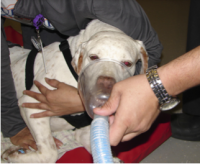
KEY POINTS
• The number of geriatric veterinary patients presented for anesthesia appears to be
increasing.
• Proper patient preparation and vigilant monitoring are the best defense against anesthetic
problems in the geriatric animal.
• Monitoring should include pulse oximetry, end-tidal CO2, blood pressure monitoring,
electrocardiogram, and temperature.
• There is no “ideal” anesthetic combination for all geriatric animals.